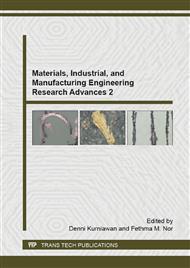p.377
p.382
p.387
p.395
p.401
p.406
p.411
p.416
p.421
Effect of Sintering Temperature on the Mechanical Properties of Nanostructured Ceria-Zirconia Prepared by Colloidal Process
Abstract:
The demand for tetragonal zirconia as a dental restorative material has been increasing because of its excellent mechanical properties and resemblance to natural tooth color, as well as its excellent biological compatibility. Cerium oxide (CeO2) has been added to yttria-stabilized zirconia (Y-TZP), and studies have demonstrated that the stability of the tetragonal phase can be significantly improved. Y-TZP with 5wt% CeO2 as a second stabilizer was developed via colloidal process, followed by a suitable sintering process. According to the literature, the sintering process is the most crucial stage in ceramic processing to obtain the most homogeneous structure with high density and hardness. This study aims to investigate the effect of sintering temperature on the mechanical properties of nanostructured ceria–zirconia fabricated via colloidal processing and slip casting process with cold isostatic pressing (CIP). Twenty-five pellet specimens were prepared from ceria–zirconia with 20 nm particle size. CeO2 nanopowder was mixed with Y-TZP nanopowder via colloidal processing. The consolidation of the powder was done via slip casting followed by CIP. The samples were divided into five different sintering temperatures with. Results from FESEM, density and hardness analyses demonstrated statistically significant increase in density and hardness as the sintering temperature increased. The hardness increased from 4.65 GPa to 14.14 GPa, and the density increased from 4.70 to 5.97 (g/cm3) as the sintering temperature increased without changing the holding time. Sintering Ce-Y-TZP at 1600 °C produced samples with homogenous structures, high hardness (14.14 GPa), and full densification with 98% of the theoretical density.
Info:
Periodical:
Pages:
401-405
Citation:
Online since:
October 2015
Price:
Сopyright:
© 2015 Trans Tech Publications Ltd. All Rights Reserved
Share:
Citation:


